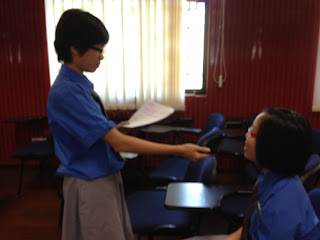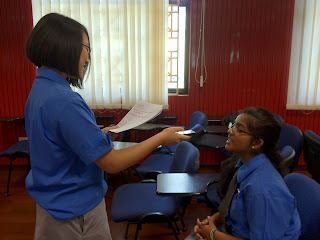Day 3 Of The Design Thinking Challenge
On Day 3, we did these 2 steps. The first thing we did when we reached school, was to take out our drafts of our idea and discuss about how we should create a prototype.
Our prototype
4) Prototype
We have already done ideating on day 2, so it was time to prototype. We had to decide how we should present it to our user and the audience later on. After much thinking, we have decided to write out our camp schedule on a big sheet of paper, and do some clay models. The hands-on activities were fun. Even though we had a hard time shaping-out the clay figures, but we had a delightful time. We made out the whole schedule from Day 1 of the camp to Day 3 of the camp. Even though our figurines were not very nice, we still put in our best effort to make them.
5) Test
We tested out our prototype, which was the schedule and clay-models, by asking people their opinions about our prototype and whether they would go to such camps and enjoy it. Initially, we wanted to hold to camp at the beach, however, after testing out our prototype on our user, we found out that it was not feasible to travel.
After refining our prototype and changing it to be held in school, we once again asked our user, Thiri, her opinions about our refined prototype and according to her, it was something that she would enjoy and would participate in. She would feel much safer to sleep over in the school, and it was a better place to get to know more about Cedar and her friends.
Most importantly, it met her needs, which was to bond with her classmates and have more fun. Overall, it was a different experience working together as a group. It had been an enjoyable and informative journey where we learned how to work with each other despite our differences.
At the end of the day, we finalized our informations and rehearsed our lines when presenting. For the past 3 days, we had a whale of time, and we hope to have such programmes in future:)
Group Reflection
Through this entire 3 days of Design Thinking and the whole term of Imagineering, we have learnt a lot of skills which could not have been in normal curriculum. In the future when we grow up, when we are in universities, high schools, or even when working, these analysing skills and the five steps, Empathy, Define, Ideate, Prototype and Test, will benefit us and give us an advantage.
Even though process we have gone through was tedious and time-consuming, it contributes greatly to our learnings. Empathy: We have learnt to put ourselves in others’ shoes and empathise with them.
After the many lessons of Imagineering Programme trying out with our fellow classmates and even teachers acting as different roles, we learnt how to empathise better and know better the actual meaning of Empathy.
Define: To make the things we have to find simpler so that we can understand the questions better.
Ideate: to brainstorms for ideas to improve the situation.
Prototype: Create ‘something’ useful with the idea that will meet the user’s needs.
Test: Test out the prototype with user to find out what it lacks, further refine it until the user is satisfied with it.
Throughout these three full days given to us to work in our assigned groups, we have learnt many skills and knowledge which could not be learnt from books and furthermore, we have came to realise how important these skills are. Even though they will not be tested in examinations yet, and it is not an actual subject, but knowing and remembering these skills will come to use in the future.
.JPG)


